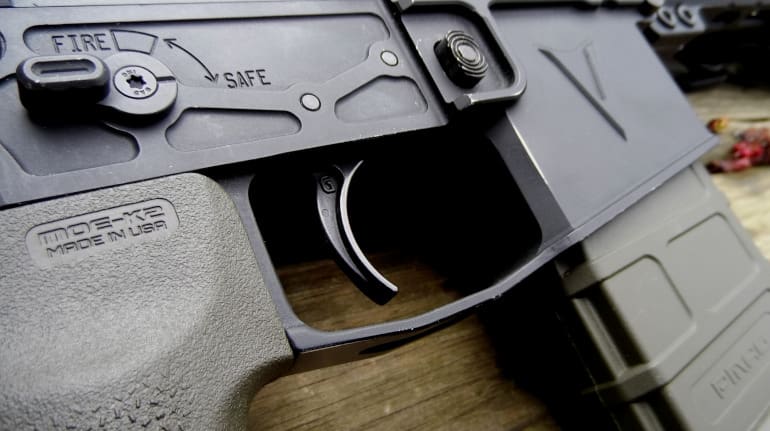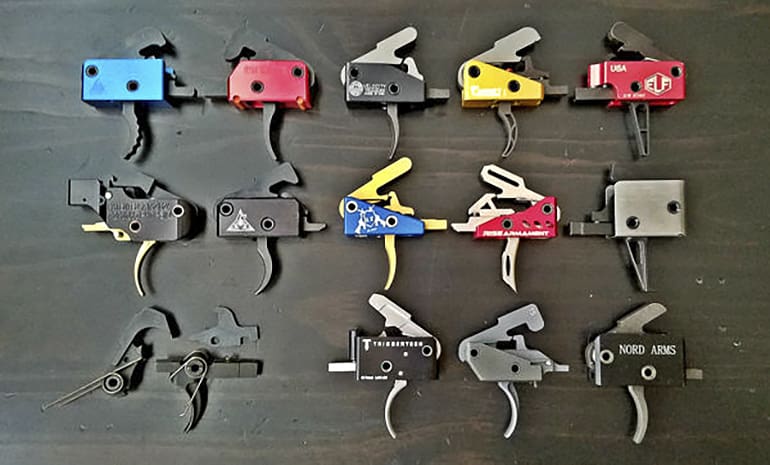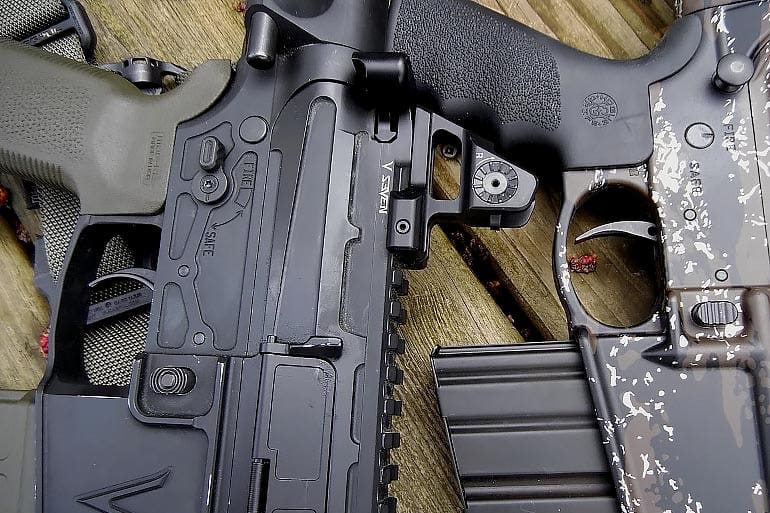The trigger is obviously one of the most important links that a shooter has to his rifle. Granted, the stock, grip, and forend all matter, but the trigger is of special importance. Today we are going to be looking at the differences between single-stage triggers and two-stage triggers and just what each offers to you.
Unlike many of my articles were I talk about which cartridges are better than 6.5 Creedmoor, I won’t try to pick a winner here, despite the fact that I have a clear favorite. The differences between single and two-stage triggers are relatively minor, but they tell me a great deal about what a shooter prioritizes and how they see their relationship to their rifle.
For the purposes of this article, I will be talking about rifles and not other guns. Handguns are a bit different and their triggers vary a great deal between single action, double action, striker-fired, and so on.
The triggers of most rifles are often easily replaced. The AR-15 rifles featured in this article can accept any type of standard trigger meant for the AR platform and aren’t permanently bound to the parts they have, unlike many types of other guns.
The technical differences between single and two-stage triggers are small, but very important. In a literal sense, there is no functional difference between the two when it comes to how the rifle operates.
For those new to guns, you may want to review our trigger terminology 101 post here.
The purpose of a rifle’s trigger — single-stage or two-stage — is to release the sear that causes the weapon to fire. A double action revolver, for instance, uses trigger pull to both rotate the cylinder and retract the hammer to fire it. There are multiple actions being performed, where there is only one function on a rifle trigger.
Allow me to explain: the two-stage trigger in a rifle is not the same a double-action trigger in a handgun. The first stage is merely what is called ‘slack’ and it doesn’t perform a mechanical function.
You begin your trigger pull with a light take-up, which is the first stage. This stage sees the trigger shoe being brought back to a stopping point, which is the second stage.
Pressing through the second stage fires the rifle. The first stage can be released should the shooter not wish to fire. Upon reset, a shooter can reset directly to the second stage, which can speed precise shooting.

A single-stage trigger is static and has no take-up or slack. When you press the trigger, there is only the break and the rifle will fire. Most single-stage triggers have lighter pull weights by comparison to their two-stage brethren.
Unlike most types of technology, the single and two-stage trigger did not develop as distinct evolutionary steps.
Since manufacturing standardization didn’t exist in any widespread capacity until the mid 1800’s, the individual gun was indeed an individual in that it was not one of many, but the only one of its make. Triggers varied greatly until mass production manufacturing was introduced.
Skipping ahead to about 1900, we see a general divide along civilian and military lines. The military rifles of the day usually had two-stage triggers while civilian arms were typically single stage. I have studied this divide for some time and have arrived at some interesting conclusions.
The military rifles that introduced true two-stage triggers were the guns of about 1890-1914 vintage. These were the Mausers, Springfields, Mosin-Nagants, Krags, and Enfields. Two-stage triggers in these rifles were generally considered more robust and reliable. A rifleman had some grace in his trigger pull thanks to the take-up stage.
Sporting rifles of the era, typically the Winchester lever action, were generally made for less stressful use and enjoyed crisp, single-stage triggers. The single-stage pull here resulted from the positioning of the trigger sear on the hammer. The light pull on many high-end lever guns is the result of this. It’s rare to find a lever gun with a two-stage trigger.
The military-style trigger began to change when fully automatic rifles were more widely introduced in the years following WWI. The M1 Garand and other excellent semi-auto rifles had two-stage triggers, but triggers became mushier and less precise with the introduction of the M16/AR-15.
Thanks to the modularity of the AR system, today’s two-stage triggers are incredible. The version featured in my 300 Blackout here was made by Geissele.

Today’s budget AR-15 rifles typically have what are called mil-spec triggers. The mil-spec trigger is something of a bastard in that it’s both heavy and gritty with a long pull. This trigger is technically a single-stage design despite the fact that the pull is often as long as that of a two-stage. If you get a quality single-stage, you will have no creep or pull at all. The trigger will simply break like a glass rod when you pull it.
If you find yourself looking to improve your rifle’s trigger, you have a few ways to go about it. I personally prefer a two-stage as I shoot in National Match and CMP competition. I also prefer them for hunting as I like to take up the trigger when I’m about to fire.
The sensation of a two-stage is very natural to me and it feels very tactile. I can ‘talk’ to my rifle better as it is easier to me to anticipate the shot and recoil follow-through.
Taking up the slack in the first stage feels like I’m zeroing in on my shot. At matches I will begin taking up slack as I hover around the black, but will only get it to the second firing stage when I’m rock steady.
My hunting rifle, a 700-based 450 Bushmaster built by my friends at Precision Rifle Company using parts supplied by Brownell’s, wears a two-stage Timney Calvin Elite trigger. It’s one of the best triggers I have ever used and it gives me great confidence in the field.
If you have been a single-stage shooter, you probably grew up shooting shotguns and sporting rifles. All the people I know who prefer a single-stage trigger got their start with dedicated hunting rifles, typically a bolt action, although that isn’t to say that they did not also shoot semi-autos.
The sport rifle has long been dedicated to a single, stiff pull and this tradition has carried through to most of today’s common rifles.

The rifle featured here is a Brenton USA 450 Bushmaster and it carries a single-stage trigger. It’s arguably the best AR-based dedicated hunting rifle made today.
The benefit of a good single-stage trigger is that you get a short and fast pull with a quick reset. This type of trigger is generally the choice for benchrest shooters and hunters.
There are some general risks associated with this type of trigger that are not present on the two-stage trigger. Drop risk and accidental discharge are far more likely with a light, single-stage trigger, although this problem is usually reserved for bolt actions rather than ARs due to how the trigger and sear are arranged. The lower the pull weight, the greater the potential danger.
How much should you consider spending on a trigger? Well, that’s all relative to what you want to get out of it. I consider $150-300 to be a good starting point if you want a no-compromise trigger from a reputable company. I don’t consider a $400 trigger to be too much depending on what sports you want to get into. You generally get what you pay for in this life and life is too short for bad triggers.
For a good overview, see Jeremy’s epic drop-in trigger roundup post.
Today we have several deep divides in the gun industry. M-LOK vs. KeyMod. AR-15 vs. AK-47. 9mm vs. 40 S&W. Mil vs. MOA.
The thing is, the market usually decides. M-LOK won. The AR is currently dominating. What’s .40 cal again?
We see one exception here and that’s Mils vs. MOA. That’s more of a matter of experience and personal preference than performance. The single-stage vs. two-stage question is much the same.
Which one should you choose? Pick whatever you want so long as you’re comfortable with it and it meets your needs. If you haven’t shot either, borrow some guns and try them both.
On the other hand, if you know MOA and grew up shooting a two-stage trigger, then go with it. You’ll be much happier in the long run than if you try to switch to Mils and single-stage just because that’s the trend in your sport of choice.





Two stage= more precision.
Single stage=quicker takedown
All my longer range guns have two stage.
All my quick aquisition and takedown guns are single
An experienced shooter what takes his meat every season will aim, fire and hit accurately, while the Mils V MOA discussion is just getting warmed up. Every variable, 1 or 2 stage trigger, iron sights or optics, mil. Vs. MOA, all of them enrich the people in the firearms accessory business. That’s all well and good. If add-on equipment brings more shooters out to the range, I’m all for that. I’m just thankful that I learned to stalk and hit my targets before all this technology sprung up. Old timers I learned from knew what caliber and gauge their rifle and shot gun were. Without anything else they always hit what they were aiming at and never came out of the woods empty handed. Makes ya’ wonder…don’t it…-30-
My triggers are both to touchy – I hold the gun relaxed on a bench and sometimes it will fire twice. The triggers are so touchy you can’t breathe on them. One is a Armalite NM and the other is H&K Competition. I think I will look into seeing if they can be stiffened up a bit.
If you are talking AR triggers, you’d be better off to check the disconnector for the “double tap”. And it’ll get worse. Initially, the way most of us operate the trigger it seems both rounds are firing on the squeeze but that’s not the case. To check this out, be certain you don’t let up finger pressure on the trigger after the first round, then release it and see if the second round fires upon release. I’ve had this happen in two of my many ARs- I think it officially becomes a “binary trigger” but neither was so-intended.
Mils. I can easily remember how to dial my .260 in out to 800 yards with MRAD, I’d have to carry a notebook with me to figure out MOA out to that range.
I put a Timney 2 stage in my AR and like it. It’s supposed to be 2+2# but feels to me more like 1+3#. Still a nice easy pull but takes 4# of booger hook negligence to make it go bang. IMHO if you’re carrying it in the field you probably should have 3.5#+. That’s hardly too stiff for me in single stage though. On a bench gun single all the way.
If you like base 10, mils is for you.
I didn’t pay much attention to MRAD until I plugged the .260 into a ballistics calculator to try and find a bullet drop reticle that worked for it. Most work OK if I sight it in at 100 but I wanted a +/-3″ zero so I don’t have to worry much inside 300 yard and none of them work for that. Turns out +2.5″ @ 100 yards = 225yd zero and +1MRAD @ 350, +2 @ 450, +3 @ 550, +4 @ 650, 5 @ 725 and 6 @ 800 (within 1/10th MRAD). 10mph cross wind = 1 MRAD @ 500 and 2 @ 800. Pays to take the individual rifle’s ballistics before deciding which way to go.
I prefer a set trigger. Which is neither of the above!
I’ve found set triggers to be too sensitive unless I’ve done some practice with one before going live.
That all depends on what the arm is being used for. I have a double set in my old SSG69 that’s perfect for precise work from a solid rest. It’d be tough to control if one was shooting off-hand or at a non-stationary target. My old Blaser Ultimate in .375 H&H has a single trigger that you push forward to set but I don’t understand the reason for it on a “dangerous game” rig. That’s what it came with, though, so WTH?
I’ll save everybody some time
$40 single El-cheapo PSA EPT or ALG QMS
$60 Single mid-level ALG ACT
$90 single premium Rise RA-140
$90 2-stage premium MBT
The MBT should be nicknamed “the disruptor” because it is probably causing a lot of heartburn for competitors.
Anything more expensive you have to seriously ask yourself if you’re being efficient with your dough.
I’ve also had good luck with the EPT and the MBT. Just ordered my third MBT. Can’t be beat for anywhere close to the price. The EPT is also great for the price point. Not for precision work, but very functional for plinking around.
With my background in UIT target rifle and service rifle, I prefer the 2-stage trigger. The No4 Lee-Enfield is my baseline. The Mk2 triggers are much better than the Mk1, but you can get used to the Mk1. Both are better than Mauser triggers, which in turn are far better than the Russian Mosin-Nagant trigger.
The single-stage Ruger Scout trigger has a very short and crisp action, so I can appreciate both.
the trigger in my M95 Styer is a bitch. the pull on that comes in at about 10# and that is after stoning the sears. not quite sure what else i could do other than backing off the tension on the firing pin spring and that can cause the pin strike to be too soft especially when using the old ex mil ammo
in my experience shooting all kinds of ammo in all my different ar pattern rifles with different optics and different triggers and moving them all around between guns im of the opinion that as far as accuracy is concerned the most important thing is barrel then ammo then optic then trigger
with the right gun and the right ammo and the right optic ive been able to shoot 1 moa or less to 300 yards with stock mil spec improved mil spec and rock river arms 2 stage
the trigger didnt matter
for me and my needs i would never spend $200 or more on a trigger
in all the lower parts kits ive purchased over the years some triggers have been better than others for sure but none of them have been bad enough to keep me from shooting good groups
not braggin just sayin
Stage 1= moving finger to the trigger
Stage 2= firing the weapon
I never place my finger on a trigger unless I have made the decision to fire that weapon and have determined a specific target after that my slightly arthritic finger appreciates the 3.5 lb single stage trigger it comes in contact with, the target, not so much…
The most wasted rounds I had was getting used to the 2.5# Hiperfire 24c I put in my target bench rifle. It WILL teach you to not touch it till you are ready to fire. After getting used to it my groups tightened considerably. When I got the 700 it was set at about 2# and I left it there. Oh yeah, Mil all the way. MOA is finer but it is easier to range with Mil.
+1 for Geissele SSA-E fancy pants trigger, its very nice (owner)
I grew up shooting Garands and Springfields.
I can’t stand single stage triggers. First thing I do with an AR is swap in a 2-stage trigger.
Yes. Mushy and less precise is a good definition of the AR platform (5.56) when comparing it to the M1 Garand. You get what you pay for in quality and ballistics (and weight 😀).
Single-Stage vs Two-Stage rifle triggers-What’s the difference? Uh, .. one stage.
Rifles or pistols, I can’t ever decide there’s a difference. However, on an AR, once upon a time, I swapped up from the stock single stage to an aftermarket 2-stage, and kicked myself for months since it did not seem to make a difference. Then I actually sat down to a bench session, and the rifle was printing groups half the size it was before. Better trigger? 2-stage instead of single? Beats hell out of me.
Single Stage for the win.